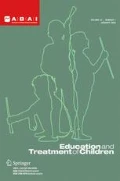Abstract
The current study investigated perceptions on reading comprehension instruction within a residential treatment facility. Four special education teachers participated in a focus group, identifying facilitators and barriers to teaching reading comprehension within a restrictive education setting to youth with and at-risk for emotional and behavioral disorders. Study findings indicate that facilitators for reading comprehension instruction within the classroom include the belief that reading is a life-long skill, the importance of differentiating instruction, and an understanding that youth learn in different ways. Contextual setting and youth attributes, a delay in academic instruction, incomplete instructional toolbox, and teacher and youth buy-in are identified barriers to reading comprehension instruction within a residential treatment facility. Suggestions for addressing these barriers, as well as future directions for research are outlined. This study highlights a need for additional investigation into stakeholder perceptions regarding reading instruction in restrictive educational settings.
References
Boden, L. J., Ennis, R. P., Allen, L., Williams, D., & Dana, L. (2020). Staff and youth buy-in ideas for initial and sustainable facility-wide positive behavior intervention and supports implementation within residential and juvenile facilities. Remedial and Special Education, 41, 88–98.
Bowen, D. J., Kreuter, M., Spring, B., Cofta-Woerpel, L., Linnan, L., Weiner, D., Bakken, S., Kaplan, C. P., Squiers, L., Fabrizio, C., Fernandez.,M. (2009). How we design feasibility studies. American Journal of Preventive Medicine, 36, 452–457.
Ennis, R. P., & Jolivette, K. (2014). Existing research and future directions for self-regulated strategy development with students with and at risk for emotional and behavioral disorders. Journal of Special Education, 48, 32–45.
Garwood, J. D., & Moore, T. (2020). School connectedness insights for teachers educating youth with a severe emotional disturbance in residential treatment. Residential Treatment for Children & Youth, 38, 153–165.
Holt, C., Fawcett, S., Francisco, V., Schultz, J., Berkowitz, B., & Wolff, T. (n.d.). Chapter 7: Involving people most affected by the problem. Community Tool Box. Center for Community Health and Development, University of Kansas. Retrieved from https://ctb.ku.edu/en/table-of-contents/participation/encouraging-involvement/identify-stakeholders/main
Jolivette, K. (2016). Multi-tiered systems of support in residential juvenile facilities. Washington, DC: National Technical Assistance Center for the Education of Neglected or Delinquent Children and Youth (NDTAC). Retrieved from https://nglected-delinquent.ed.gov/sites/default/files/NDTAC-IssueBrief-508.pdf
Jolivette, K., Boden, L. J., Sprague, J. R., Ennis, R. P., & Kimball, K. A. (2015). Youth voice matters: PBIS implementation in secure residential juvenile facilities. Residential Treatment of Children & Youth, 32, 299–320.
Jolivette, K., Swoszowski, N. C., Ennis, R. P., & Nihles, J. (2020). FW-PBIS Tiered Fidelity Inventory tool for use in 24/7 delivery models in residential and juvenile justice facilities: Process for blending researchers and stakeholder input. Residential Treatment of Children & Youth, 41, 99–110.
Lewins, A., & Silver, C. (2007). Using software in qualitative research.: A step-by-step guide. Thousand Oaks, CA: SAGE.
Sanders, S. (2020). Using self-regulated strategy development to teach reading comprehension strategies to elementary students with disabilities. Education & Treatment of Children, 43, 57–70.
Silver, C., & Lewins, A. (2014). Qualitative coding in software: Principles and processes. In Using software in qualitative research: A step-by-step guide Thousand Oaks, CA: SAGE.
Sun, Y. (2018). Coding of data. In M. Allen (Ed.), The Sage encyclopedia of communication research (pp. 149–151). Sage.
Wexler, J., Kearns, D. M., Lemons, C. J., Mitchell, M., Clancy, E., Davidson, K. A., Sinclair, A. C., Wei, Y., et al. (2018). Reading comprehension and co-teaching practices in middle school English language arts classrooms. Exceptional Children, 84, 384–402.
Yan, M., & Wilkerson, K. L. (2017). Reading instruction in juvenile correctional facilities for students with and without disabilities. Journal of Correctional Education, 68(2), 37–61.
Funding
Funding for this study was in part provided by the Office of the Vice President for Research and Economic Development at the University of Alabama. The opinions expressed are those of the authors and not necessarily of the funding agency.
Author information
Authors and Affiliations
Corresponding author
Ethics declarations
Conflict of Interest
On behalf of all authors, the corresponding author states that there is no conflict of interest.
Ethics Approval
Approval was obtained from the Institutional Review Board. The procedures used in this study adhere to the tenets of the Declaration of Helsinki.
Consent
Informed consent was obtained from all individual participants included in the study.
Rights and permissions
About this article
Cite this article
Sanders, S., Jolivette, K., Michael, E. et al. Reading Comprehension Feasibility Perspectives from Teachers of a Residential Children’s Treatment Facility: A Focus Group Study. Educ. Treat. Child. 44, 31–36 (2021). https://doi.org/10.1007/s43494-021-00035-5
Accepted:
Published:
Issue Date:
DOI: https://doi.org/10.1007/s43494-021-00035-5

